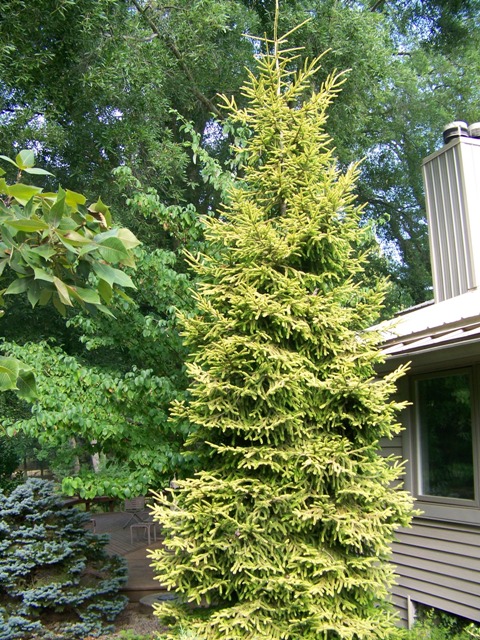Picea orientalis ‘Skylands’ – Yellow Oriental Spruce
DESCRIPTION
This slow-growing spruce produces abundant, pendent branches from ground level up. The new candles are chartreuse-yellow. The needles retain their golden charm all year round, contrasting with the greener needles in the shaded interior of the tree. In winter, the golden tones are a welcome relief from the eight months of gray our weather gives us and the monotonous dark green vistas our region is famous for. The brown bark exfoliates in thin scales, adding additional interest. In spring, the young carmine-red flowers, resembling strawberries, are soon followed by reddish-purple cones that turn brown as they mature.
LOCATION
Oriental spruce comes originally from the Caucasus and Turkey.
CULTURE
Oriental spruce is a slow growing tree (slower than other spruces). It won’t need any pruning; let it grow into its natural, graceful shape.
Light: Full sun to partial shade. The cultivars with yellow foliage develop their best color when grown in full sun.
Moisture: The spruces do best in moderately moist, but still well-drained, soils. Oriental spruce is a little more tolerant of dry, sandy soils than the other species, but cannot be considered drought tolerant.
Hardiness: USDA Zones 4 – 8. Oriental spruce is marginal in zone 4. It should be given a location sheltered from strong winter winds. Said to be superior to other spruces in the south, oriental spruce can be grown to zone 8A at least, where it may benefit from partial shade.
Propagation: Oriental spruce can be grown from seed, which requires no pretreatment. Standard sized cultivars are grafted onto seedling rootstock, but dwarf cultivars should be started from cuttings because they grow too vigorously on normal rootstocks. Spruces tend to be difficult to start from cuttings and success rates are usually low.
USAGE
With its extremely dense foliage and elegant habit, oriental spruce is an excellent specimen conifer for medium sized to large areas. Many professional landscapers consider it superior to the more commonly cultivated Norway Spruce. Use oriental spruce as a lawn specimen or massed for screening. The dwarf cultivars are excellent in hedges and as anchors for foundation plantings and shrub borders.
FEATURES
Oriental spruce has a powerful and formal shape, and is perhaps the most graceful of the 30 spruce species cultivated in the U.S.

